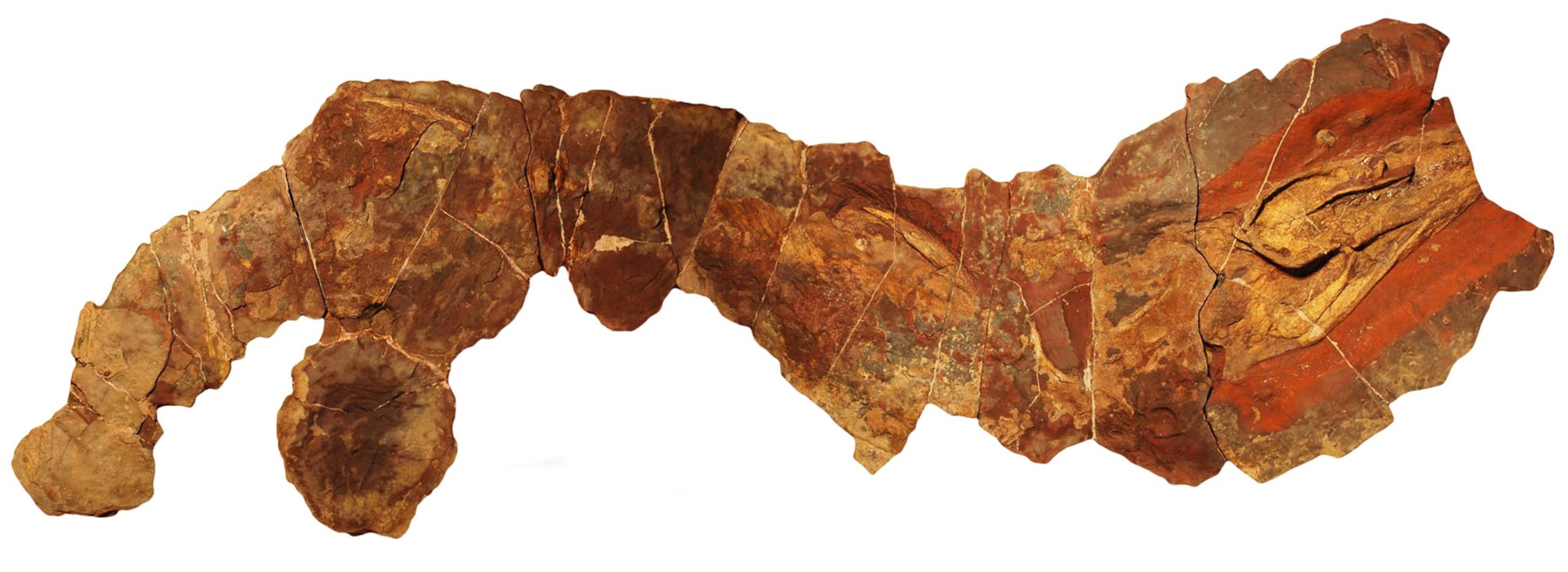Shark teeth are among the most commonly found fossils around the world, yet the cartilage-based skeletons of their owners were rarely preserved. As a result, researchers have no idea what many early sharks looked like, even if they were once very abundant.
That’s why paleontologists working in the eastern Anti-Atlas Mountains of Morocco were stunned to find several skulls and an almost complete skeleton from two species of Phoebodus, a primitive shark genus that, until now, was known only from its three-cusped teeth. Described this week in Proceedings of the Royal Society B, the fossils reveal that Phoebodus had an eel-like body and a long snout, which makes it look a lot like the frilled shark that still roams the deep sea today. (Explore our interactive showcasing the sizes of the world’s sharks.)

And while these two animals are only distantly related, the teeth of Phoebodus and those of the frilled shark look really similar as well, suggesting that their feeding modes didn’t differ drastically.
“Many modern sharks have serrated teeth that allow them to cut up their prey before ingesting the pieces,” says study coauthor Christian Klug of the University of Zurich. By contrast, the cone-shaped, inward-pointing teeth of Phoebodus and the frilled shark are only good for capturing prey and then swallowing it whole.
Snapping sideways
The fossilized Phoebodus remains were found in a layer estimated to be about 360 to 370 million years old, in what used to be a shallow sea basin. When the sharks died there, the limited water circulation and low oxygen levels created an environment in which their bodies were largely left alone by bacteria, scavengers, and currents, preserving them for posterity.
The resulting fossils are damaged by sediments and time, but Klug and his team were able to CT scan some of the material they recovered from the Moroccan mountains to get an even better picture of what these primitive sharks looked like during the Late Devonian period.
“The quantity of data that is emerging from studies such as this is staggering,” says John Maisey, a paleontologist with the American Museum of Natural History who was not part of the study team. “We are experiencing a renaissance of anatomy.”
The scans revealed some striking similarities to the frilled shark, not just in body shape, but in the teeth as well, which offers some clues to how the more ancient predators might have hunted. (Find out why great white sharks may be responsible for the extinction of the Megalodon.)
“The frilled shark is a specialized predator, with the ability to suddenly burst forward to catch its prey,” says David Ebert, a modern shark expert at the Pacific Shark Research Center who has studied the frilled shark for decades. “The inward-pointing teeth then help to make sure the prey can only go one way: into its throat. Maybe Phoebodus did something similar.”
Because the reclusive frilled shark is so rarely observed, however, there are many outstanding questions about the way it feeds. So, for a better understanding of how Phoebodus may have gotten its food, the researchers also looked at another unrelated species with a surprisingly similar skull, jaw, and teeth, a large freshwater fish called the alligator gar. Like Phoebodus, the alligator gar has long jaws and a flat skull, which limit its bite force. Yet there are also benefits to having a head like that, says Justin Lemberg of the University of Chicago, who has studied the gars’ feeding behavior.
“They hunt in open water, where they don’t have the luxury of choosing which direction their next meal will come from. And flat heads and long jaws are great for snapping sideways at prey.”
Physics of feeding
While it may seem unusual to compare the feeding strategies of species as different as sharks and gars, such analyses are often among the best ways paleontologists have to reconstruct how extinct animals behaved, Lemberg says.
“When a certain structure or strategy is effective, there is a tendency for it to show up time and time again—both in living creatures and in the fossil record,” he says. “While a lot has changed since Phoebodus swam the Devonian oceans, the physics of feeding in water have not.”
Nevertheless, Phoebodus went extinct in the early Carboniferous, millions of years before the re-emergence of some of its features in a modern shark. So, might some species belonging to this ancient genus still be lurking in the deep, like the elusive frilled shark?
“I really don’t think so,” Ebert says. “I’ve spent a career looking for new species, but I’ve never come across anything quite like this.”






